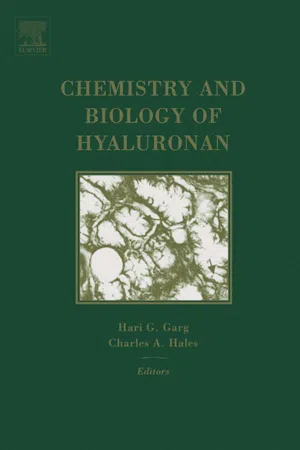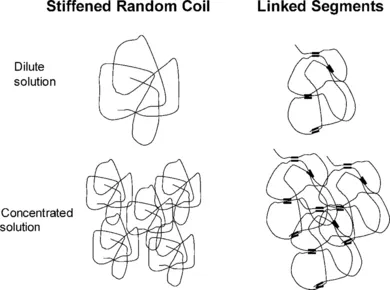
- 624 pages
- English
- ePUB (mobile friendly)
- Available on iOS & Android
Chemistry and Biology of Hyaluronan
About This Book
It was probably the French chemist Portes, who first reported in 1880 that the mucin in the vitreous body, which he named hyalomucine, behaved differently from other mucoids in cornea and cartilage. Fifty four years later Karl Meyer isolated a new polysaccharide from the vitreous, which he named hyaluronic acid. Today its official name is hyaluronan, and modern-day research on this polysaccharide continues to grow.
Expertly written by leading scientists in the field, this book provides readers with a broad, yet detailed review of the chemistry of hyaluronan, and the role it plays in human biology and pathology. Twenty-seven chapters present a sequence leading from the chemistry and biochemistry of hyaluronan, followed by its role in various pathological conditions, to modified hylauronans as potential therapeutic agents and finally to the functional, structural and biological properties of hyaluronidases. Chemistry and Biology of Hyaluronan covers the many interesting facets of this fascinating molecule, and all chapters are intended to reach the wider research community.
- Comprehensive look at the chemistry and biology of hyaluronans
- Essential to Chemists, Biochemists and Medical researchers
- Broad yet detailed review of this rapidly growing research area
Frequently asked questions
Information
I. Introduction
II. Historical Perspective

Table of contents
- Cover image
- Title page
- Table of Contents
- Copyright
- Dedication
- Preface
- Contributors
- Chapter 1: Solution Properties of Hyaluronan
- Chapter 2: Methods for Analysis of Hyaluronan and Its Fragments
- Chapter 3: Methods for Determination of Hyaluronan Molecular Weight
- Chapter 4: Biodegradation of Hyaluronan
- Chapter 5: The Hyaluronan Receptor: CD44
- Chapter 6: The Role of the Hyaluronan Receptor RHAMM in Wound Repair and Tumorigenesis
- Chapter 7: Signal Transduction Associated with Hyaluronan
- Chapter 8: Structural and Functional Diversity of Hyaluronan-Binding Proteins
- Chapter 9: Biological Function of SHAP–Hyaluronan Covalent Complex
- Chapter 10: Hyaluronan and Associated Proteins in the Visual System
- Chapter 11: Hyaluronan in the Pulmonary Alveolus and Interstitium
- Chapter 12: Hyaluronan in Ventilator-Induced Lung Injury
- Chapter 13: The Role of Hyaluronan in Cancer
- Chapter 14: Hyaluronan in Atherosclerosis and Restenosis
- Chapter 15: Hyaluronan in the Airways
- Chapter 16: Hyaluronan Biology in Vocal Fold Morphology and Biomechanics
- Chapter 17: Hyaluronan in Aging
- Chapter 18: Hyaluronan and Scarring
- Chapter 19: Hyaluronan in the Epidermis and Other Epithelial Tissues
- Chapter 20: Viscoelastic Properties of Hyaluronan and Its Therapeutic Use
- Chapter 21: Medical Application of Hyaluronan
- Chapter 22: Therapeutic Biomaterials from Chemically Modified Hyaluronan
- Chapter 23: Medicinal Uses of Modified Hyaluronate
- Chapter 24: Hyaluronan in the Treatment of Ocular Surface Disorders
- Chapter 25: The Hyaluronan Synthases
- Chapter 26: Molecular Genetic Dissection of Hyaluronan Function in the Mouse
- Chapter 27: Functional, Structural and Biological Properties of Hyaluronidases
- Subject index